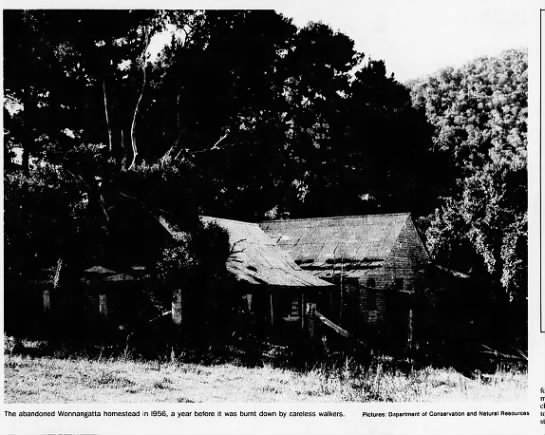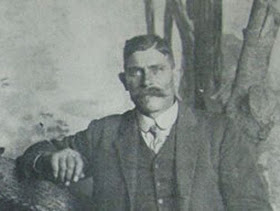 |
| "The Age," September 26, 1993, via Newspapers.com |
True crime historian William Roughead once commented that the "setting of a great crime" should be properly "forbidding": "Murder, to be fully effective, should be done out of doors, and if possible amid surroundings agreeably savage."
Wonnangatta Station, a cattle ranch located in an isolated valley in Australia's Victoria Alps, is to this day a harsh and lonely spot. In the early 20th century, it was as "out of doors" and "agreeably savage" a place as any murder fancier could hope to find.
So far as I know, the Edinburgian Mr. Roughead had never even heard of the place, but it would have gratified him immensely to know that Wonnangatta hosted one of Australia's most notorious murder mysteries.
Beginning some time in 1916, Wonnangatta Station was run by a man named James Barclay. He had been working alone there for some time, but in December 1917 he hired one John Bamford to act as cook and general handyman. The two seemed a mismatched couple. Barclay had a good reputation, both professionally and personally, but Bamford was widely disliked, as he was a quick-tempered, surly sort who was fond of quarreling. There were even rumors that he had murdered his wife. However, the two men seemed to get on well enough.
About a week after Bamford was hired, the pair traveled to the town of Talbotville, about twenty miles from the station, in order to vote on a referendum on introducing the military draft. (If any of you are curious, it is recorded that the pair voted the same way, but it is lost to history whether they were for or against the measure.) They spent the night at the home of a mutual friend, Albert Stout, and the next morning, December 21, the two men began the ride back to Wonnangatta, little knowing that their recent votes would prove to be totally irrelevant to either of them.
The next time anyone had any reason to visit Wonnangatta was on January 22, 1918, when a local man named Harry Smith visited the station to deliver some mail. He was perplexed to find no one there. The only clue to the whereabouts of the men was the message "Home tonight," written on the door of the kitchen. Assuming that one or both of the men would turn up at any moment, Smith decided to wait around for them. When after two days, there was still no sign of Barclay or Bamford, Smith gave up. Without making any further investigation, he shrugged off the mystery and returned home.
On February 14, Smith returned to Wonnangatta. When he saw that nothing had been touched since his last visit--the unopened mail was just as he had left it and Barclay's dog, Baron, was obviously starving--it finally dawned on Smith that something very awful must have happened. He stayed there overnight, doing a fruitless search for some sign of the men, and the next morning traveled to the nearest town, Dargo, to report that Barclay and Bamford had vanished. He also sent telegrams to the ranch's owners alerting them to what had happened.
Police were notified, and a search party was quickly assembled. The bedrooms of the two men were disarranged, as if they had been ransacked. Some of Bamford's possessions, including his horse, were missing. (The horse--which was lacking its saddle and bridle-- was later found running wild over the plains.)
Barclay's shotgun was found in his room. It had been used some time recently, and there was an empty cartridge on the floor. There was, however, no blood or any other obvious signs of violence in the house. Oddest of all, a pepper pot in the kitchen was discovered to contain large amounts of strychnine.
Less than a quarter-mile from the house, the search party's worst fears were realized when they discovered a man's skull poking out of a shallow grave. A bit of digging uncovered the rest of the body. The belt and tobacco pouch found with it helped identify the corpse as that of James Barclay.
Barclay's autopsy revealed that he had been killed by a single shot through the back. Time of death was estimated as some time between December 21 and January 4. No strychnine was found in his system.
While no one could say why Barclay was murdered, police had little trouble naming his probable murderer: John Bamford. It seemed obvious that the two had fought, after which Bamford shot his employer, grabbed a few belongings, and fled. A reward of £200 pounds was offered for any information regarding this dangerous fugitive, and a statewide manhunt was on.
 |
| James Barclay, via East Gippsland Historical Society |
The hunt for Bamford dragged on without finding the slightest trace of him. It was as if he had somehow managed to vanish from the face of the earth. His whereabouts remained an utter mystery until early November 1918, when the search ended in a most unexpected way. Some men were scouring the Howitt Plains, an area about twenty miles from the station, and near where Bamford's horse had been recovered. They came across an old abandoned hut. Outside of this hut was a pile of logs. The logs, they noticed, had a man's boot sticking out from under them. Attached to this boot was what was left of the erstwhile murder suspect, John Bamford. An examination proved that he had been killed by a shot to the head. The authorities were disconcerted to realize that they were dealing with not just one bizarre unsolved murder, but two.
To this day, this is about all we know for certain about the deaths of James Barclay and John Bamford. The police had no success whatsoever in solving the riddle of why the men were killed, let alone by whom. Naturally, many theories have been floated in the century since they died: Perhaps Bamford killed Barclay, only to be assassinated by his victim's friends in revenge? Or were both men slain by some passing robbers or horse thieves? Was James Barclay, who had a reputation as a "ladies' man," killed by some jealous rival, who then murdered Bamford in order to silence the only witness to the crime? Could Harry Smith, the first man to alert the world to the mystery, have known more than he ever let on? Who knows? As for that strychnine-filled pepper pot, well, as far as I know no one has ever even tried to explain that one. The Wonnangatta Station Murders have remained one of Australia's most solution-defying crimes.
Adding to the enigma is a statement made by Barclay's son, James Jr., when he was interviewed about the case in the 1970s. He commented, "It was all a long time ago and both the murderers are long since dead. I can't see that anything can be gained now, it's all best forgotten."
"Both the murderers?" What did the younger Barclay know about the mystery? And why did he obviously wish it to remain a mystery?
Bamford could have shot himself, after killing Barclay, but someone would have had to find his body and bury it under the logs. It may have been as simple as someone not wanting to dig a grave for a stranger's body that he discovered while wandering; perhaps a tramp who thought he would be blamed for Bamford's death...
ReplyDeleteWas Barclay Jr asked about his comment at the time of the interview?
ReplyDeleteNot as far as I know. You'd think that was the kind of statement that called for a little elaboration.
DeleteWhat a wonderful case! Roughead would have loved this one. Just want to tell you that I eagerly open Strange Company and Horrible Sanity each morning. It's time I said thank you. So thank you!
ReplyDeleteIn the absence of any definite facts, we must make do with what is most probable. Barclay was widely considered to be a decent man and a good citizen and his remains were found close to his place of residence. Therefore, it’s most likely that he was killed by the quick-tempered Bamford in a quarrel and buried nearby. Bamford’s remains were found twenty miles away, which indicates that he must have gone there under his own power – or at least, that of his horse – and must not have had any significant wound that would impede his movements.
ReplyDeleteThat seems to rule out any fight in which the two participants mortally wounded each other. It points to Bamford killing Barclay in anger – due to the lack of any other known motive - and then fleeing to a remote hideout. Somebody then followed his tracks and exacted revenge for the murder of James Barclay. The only “somebody” we know of is Harry Smith. Therefore, the most likely explanation is that Smith discovered the murder of James Barclay and took a private revenge on the only man who could have done it.
That would explain why James Jr. talked about two murderers (both long deceased) and why he didn’t want the whole issue to be re-opened.
The strychnine was probably used to poison rats and other pests, which is was why it was stored quite openly in a pepper pot.
This sounds like something right out of Ambrose Bierce, especially the vast, bare, outback setting, and the two rough men of contrasting character. Australia certainly has its share of bizarre crimes. Are you familiar with, or have you covered, the (very weird) Gatton murders of 1898 in Australia - three people (and a horse) killed around the holidays, in what seemed to be a ritualistic manner, and no clue to the murderer(s) to this day.
ReplyDeleteYes, I've read about the Gatton murders--that case was a particular horror. I may write about it some day, but that one so creeps me out I'm not sure if I want to dwell on it.
Delete"They spent the night at the home of a mutual friend, Albert Stout, and the next morning, December 21, the two men began the ride back to Wonnangatta, little knowing that their recent votes would prove to be totally irrelevant to either of them."
ReplyDeleteAs the last person confirmed to have seen Barclay and Bamford, Stout would be considered a suspect in my eyes. Was he interviewed afterwards?
I *presume* he was—it seems a logical move—but I don’t know for sure.
Delete